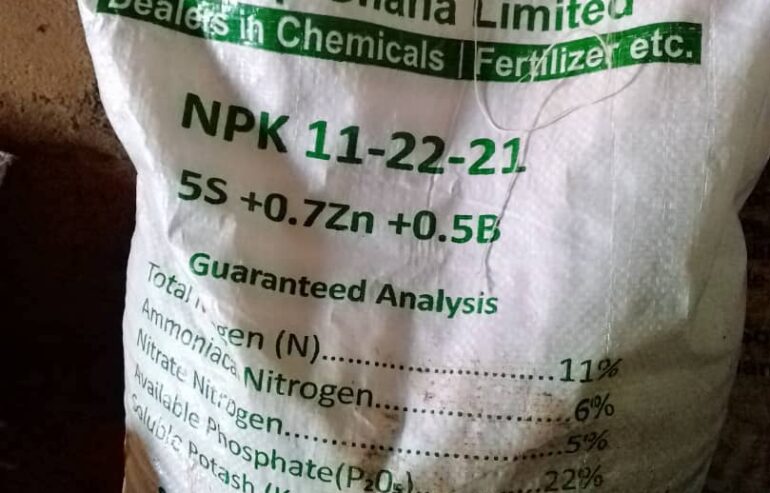
Let's stay in touch
Visit Our Office
Contact Us
-
info@intercontinentalgroupghltd.com
+(233)302 791 930
New Fertilizer Blends, the way for Ghana
Deprecated: trim(): Passing null to parameter #1 ($string) of type string is deprecated in /home/inteqwyr/public_html/wp-content/plugins/leganic-core/breadcrumb-navxt/class.bcn_breadcrumb.php on line 121
Deprecated: trim(): Passing null to parameter #1 ($string) of type string is deprecated in /home/inteqwyr/public_html/wp-content/plugins/leganic-core/breadcrumb-navxt/class.bcn_breadcrumb.php on line 121
Intercontinental > Blog > News > New Fertilizer Blends, the way for Ghana

In spite of agriculture being a leading growth driver for Ghana’s economy, its potential contribution to growth and development has been underexploited mainly due to a variety of challenges.
Soil Fertility issues in Ghana
The Abuja summit on fertilizer declared that, Sub-Saharan Africa can only increase food production and alleviate poverty when fertilizer use is increased.
Reports by Climate Change and Sustainable Development, indicates that, fertilizer application in Ghana is approximately 15kg ha-1 with the highest depletion rates in Africa ranging from about 40 to 60 kg of Nitrogen, Phosphorus, and Potassium (NPK) ha-1 yr-1
Fertilizer subsidy in Ghana began in 2008 due to significant increases in fertilizer prices, the aim was to encourage affordability and fertilizer usage.
Despite the implementation of the subsidy program, its purpose is still striving to gain grounds as result, Ghana over the years has missed the Abuja Declaration to increase fertilizer usage among farmers.
Fertilizer recommendation for the past decades
It is the practice of targeting farmers with a blanket rates of 2+1 Technology (usually 2 bags of 50kg NPK and 1 bag of 50kg of Urea or Sulphate of Ammonia per acer. Over the years, this equation has not yielded any better results.
Efforts by Consortium of Scientist
The limiting factor to fertilizer use in Ghana is the lack of fertilizer recommendations. Soil Research Institute of the Council for Scientific and Industrial Research (SRI-CSIR) has therefore introduced new fertilizer recommendations and blends for the Guinea Savannah and Forest-Savanna Transition Agro-ecological Zones of Ghana.
The goal therefore is to help improve efficiency and profitability in fertilizer use in Ghana within the frame work of Integrated Soil Fertility Management (ISFM) practices under small holder farming.
The research equally aimed at achieving improve use of research data to support fertilizer recommendations and to improved access to information and communication materials for extension.
Results of three years of implementation of fertilizer recommendations were arrived at for two agro ecological zones as show below;
Table 1: Fertilizer recommendations for maize cassava, soybean and rice in the Forest Savannah Transition and Guinea Savannah zones of Ghana
| Crop | Agro –Ecology | NPK Recommendations | Recommended blends/hector |
| Maize | Forest-Savannah Transition Zone | N-P2O55-K2O:90-60-60+1.7 Zn | N-P2O55-K2O:15-20-20+0.7 Zn(8 bags/ha +2bags/ha urea) |
| Maize | Guinea Savannah zone | N-P2O55-K2O:100-40-40 | N-P2O55-K2O:15-20-20 (4bags/ha +2 bags/ha urea) |
| Cassava | Forest-Savannah Transition
Zone/Guinea savannah |
N-P2O55-K2O:100-30-30 | N-P2O55-K2O:17-10-10
(6 bags/ha +2 bags/ha urea or 4.5 bags/ha SoA) |
| Soybean | All Ecologies | N-P2O55-K2O:20-60-30 +0.8Zn | N-P2O55-K2O:12-30-17+0.4 Zn (4bags/ha) |
| Rice
(lowland) |
Guinea Savannah zone/Forest Savannah Transition | N-P2O55-K2O:90-60-60 | N-P2O55-K2O:15-20-20
(6 bags/ha +2 bags/ha urea of 4 bags/ha SoA) |
| Rice (upland) | Guinea Savannah zone/Forest Savannah Transition | N-P2O55-K2O:90-40-40 | N-P2O55-K2O:15-20-20
(4 bags/ha+3 bags/ha urea or 6 bags SoA) |
A validation studies for the new mineral fertilizer recommendation and formulated blends was held in Sunyani under the chairmanship of Mr Seth Osei Akoto, Director of Crops Services of MoFA. The forum finalised the project the implementation plan as follows;
- Introduction of new fertilizer blends formulated for four 4 major crops for the Brong-Ahafo and the Northern regions of Ghana.
- Fertilizer companies to liaise and support SRI to develop recommendations for other ecological zone.
- Research efforts by the CSIR-SRI to consider the inclusion of other secondary and micro –nutrients such as B,S Mg, Mo and Mn.
- Soil testing should incorporated fertilizer management programmes for all crops across the country.
Subsequent to the inception workshop, validation trials were conducted in 17 Districts in the Brong Ahafo and 15 Districts in the Northern Regions covering a total of 1,650 farmers and the results are presented below.
Table 2. Recommended Fertilizer Formulae for blends for maize, cassava, soybean and rice
| Crop | Agro-Ecology | Recommended Fertilizer Formulae for Blends |
| Maize | Forest-Savannah Transition Zone | N-P2O5-K2O:
15-20-20+0.7 Zn (6 bags/ha + 2 bags/ha urea) |
| Maize | Guinea Savannah zone | N-P2O5-K2O: 15-20-20
(4 bags/ha + 2 bags/ha urea) |
| Cassava | Forest-Savannah Transition
Zone/Guinea savannah |
N-P2O5-K2O: 17-10-10
(6 bags/ha +2 bags/ha urea) |
| Soybean | All Ecologies | N-P2O5-K2O: 12-30-17 + 0.4Zn
(4 bags/ha) |
| Rice
(Lowland) |
Guinea Savannah zone/Forest Savannah Transition | N-P2O5-K2O: 15-20-20
(6 bags/ha + 2 bags/ha urea or 4 bags/ha SoA) |
| Rice
(Upland) |
Guinea Savannah zone/Forest Savannah Transition | N-P2O5-K2O: 15-20-20
(4 bags/ha + 3 bags/ha urea) |
Table 3: Yield (t/ha) from field validations on New Fertilizer Recommendations using new Blends/Formulae
| Crop | Agro-Ecology | Mean | Min | Max |
| Maize | Forest-Savannah Transition Zone | 6.00 | 3.08 | 9.50 |
| Maize | Guinea Savannah zone | 4.5 | 1.36 | 6.54 |
| Cassava | Forest-Savannah Transition
Zone/Guinea savannah |
– | – | – |
| Soybean | All Ecologies | 2.1 | 0.83 | 2.4 |
| Rice
(Lowland) |
Guinea Savannah zone/Forest Savannah Transition | 6.5 | 3.45 | 7.84 |
| Rice
(Upland) |
Guinea Savannah zone/Forest Savannah Transition | 2.8 | 1.4 | 3.5 |
Considerably more plant nutrients are being removed than are being applied, consequent of the lack of data about soils in Ghana.
To achieve the expected results or yields, the above fertilizer recommendations and blends must be strictly adhered to.